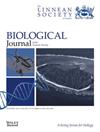饲养密度对沙蟋(Gryllus firmus)(直翅目:蝼蛄科)雌性繁殖投资和黑色素包裹反应的影响
IF 1.5
3区 生物学
Q3 EVOLUTIONARY BIOLOGY
引用次数: 0
摘要
密度依赖性预防假说认为,由于病原体预计会在拥挤环境中的同种生物之间传播,生活在这种环境中的个体应该通过提高自身的基础免疫力来最大限度地减少感染机会,并最大限度地提高存活率。此外,如果在拥挤条件下发育的个体确实将更多的资源分配给了免疫,那么分配给其他生活史特征(如繁殖)的资源就应该减少。我们在实验室中以低密度或高密度饲养沙蟋(Gryllus firmus),并对其成年期的免疫功能(黑色素包裹反应)和生殖投资(卵巢质量、卵子大小)进行量化,从而验证了上述假设。结果并不支持密度依赖性预防假说,但我们确实发现饲养密度对两种生殖性状的投资有显著影响,低密度蟋蟀的平均卵巢质量和卵子大小都较大。我们讨论了在我们的研究中免疫和繁殖之间缺乏权衡的可能原因。本文章由计算机程序翻译,如有差异,请以英文原文为准。
Effect of rearing density on female investment in reproduction and melanotic encapsulation response in the sand cricket (Gryllus firmus) (Orthoptera: Gryllidae)
The density-dependent prophylaxis hypothesis posits that because pathogens are expected to be transmitted among conspecifics in crowded conditions, individuals living in such conditions should minimize their chance of infection and maximize survival by elevating their baseline immunity. Further, if individuals developing in crowded conditions indeed allocate more resources to immunity then resource allocation to other life-history traits, such as reproduction, should decline. We tested these hypotheses by rearing sand crickets (Gryllus firmus) at either low or high density in the laboratory and quantified immune function (melanotic encapsulation response) and reproductive investment (ovary mass, egg size) at adulthood. The results did not support the density-dependent prophylaxis hypothesis, but we did find that rearing density significantly affected investment in two reproductive traits, with average ovary mass and egg size both being larger in low-density crickets. We discuss possible explanations for the lack of a trade-off between immunity and reproduction in our study.
求助全文
通过发布文献求助,成功后即可免费获取论文全文。
去求助
来源期刊
CiteScore
4.30
自引率
10.50%
发文量
140
审稿时长
3-6 weeks
期刊介绍:
The Biological Journal of the Linnean Society is a direct descendant of the oldest biological journal in the world, which published the epoch-making papers on evolution by Darwin and Wallace. The Journal specializes in evolution in the broadest sense and covers all taxonomic groups in all five kingdoms. It covers all the methods used to study evolution, whether whole-organism or molecular, practical or theoretical.d.

 求助内容:
求助内容: 应助结果提醒方式:
应助结果提醒方式:


